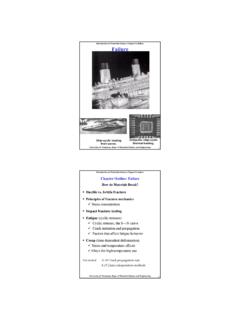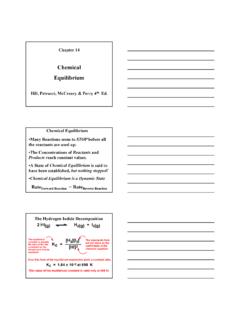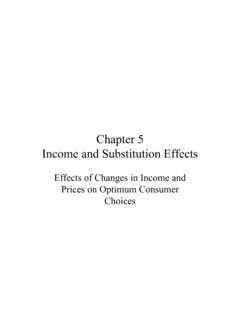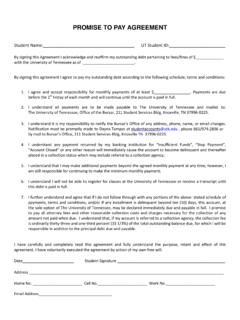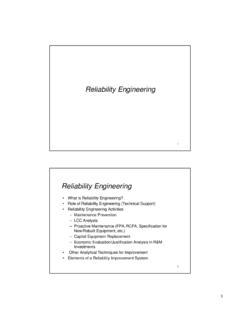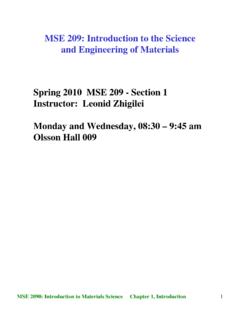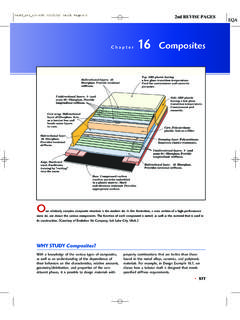Transcription of Introduction to Materials Science, Chapter 15, …
1 1 Introduction to Materials Science, Chapter 15, Polymer StructuresUniversity Tennessee, Dept. of Materials Science and Engineering1 Chapter Outline: Polymer Structures Hydrocarbon and Polymer Molecules Chemistry of Polymer Molecules Molecular Weight and Shape Molecular Structure and Configurations Copolymers Polymer CrystalsOptional reading: noneIntroduction to Materials Science, Chapter 15, Polymer StructuresUniversity Tennessee, Dept. of Materials Science and Engineering2 Polymer- a large molecule consisting of (at least five) repeated chemical units (`mers') joined together, like beads on a string. Polymers usually contain many more than five monomers, and some may contain hundreds or thousands of monomers in each chain. Polymers may be natural, such as cellulose or DNA, or synthetic, such as nylon or : IntroductionMany of the most important current research problems involve polymers. Living organisms are mainly composed of polymerized amino acids (proteins) nucleic acids (RNA and DNA), and other biopolymers.
2 The most powerful computers -our brains - are mostly just a complex polymer material soaking in salty water! We are just making first small steps towards understanding of biological systems. Silk fiber is produced by silk worms in a cocoon, to protect the silkworm while it metamorphoses in a moth. 2 Introduction to Materials Science, Chapter 15, Polymer StructuresUniversity Tennessee, Dept. of Materials Science and Engineering3 Most polymers are organic, and formed from hydrocarbon molecules Each C atom has four e-that participate in bonds, each H atom has one bonding e-Hydrocarbon molecules (I)Methane, CH4 Propane, C3H8 Ethane, C2H6 Examples of saturated(all bonds are single ones) hydrocarbon molecules: Introduction to Materials Science, Chapter 15, Polymer StructuresUniversity Tennessee, Dept. of Materials Science and Engineering4 Double and triple bonds can exist between C atoms (sharing of two or three electron pairs).
3 These bonds are called unsaturated bonds. Unsaturated molecules are more reactiveHydrocarbon molecules (II)Ethylene, C2H4 Acetylene, C2H2H-C H-CIsomersare molecules that contain the same atoms but in a different arrangement. An example is butane and isobutane:Butane C4H10 Isobutane3 Introduction to Materials Science, Chapter 15, Polymer StructuresUniversity Tennessee, Dept. of Materials Science and Engineering5 Many other organic groups can be involved in polymer molecules. In table above, R represents a radical, an organic group of atoms that remain as a unit and maintain their identity during chemical reactions ( CH3, C2H5, C6H5)Hydrocarbon molecules (III) Introduction to Materials Science, Chapter 15, Polymer StructuresUniversity Tennessee, Dept. of Materials Science and Engineering6 Polymer molecules Polymer molecules are very large: macromolecules Most polymers consist of long and flexible chains with a string of C atoms as a backbone.
4 Side-bonding of C atoms to H atoms or radicals Double bonds are possible in both chain and side bonds A repeat unit in a polymer chain ( unit cell ) is a mer A single mer is called a monomer4 Introduction to Materials Science, Chapter 15, Polymer StructuresUniversity Tennessee, Dept. of Materials Science and Engineering7 Chemistry of polymer molecules (I) Ethylene (C2H4) is a gas at room temp and pressure Ethylene transforms to polyethylene(solid) by forming active mers through reactions with an initiator or catalytic radical (R.) (.) denotes unpaired electron (active site)3. Termination: When two active chain ends meet each other or active chain ends meet with initiator or other species with single active bond:2. Rapid propagation ~1000 mer units in 1-10 ms:Polymerization: 1. Initiation reaction: Introduction to Materials Science, Chapter 15, Polymer StructuresUniversity Tennessee, Dept.
5 Of Materials Science and Engineering8 Chemistry of polymer molecules (II)Replace hydrogen atoms in polyethylene: make polytetraflouroethylene(PTFE) TeflonReplace every fourth hydrogen atom in polyethylene with Cl atom: polyvinyl chlorideReplace every fourth hydrogen atom in polyethylene with CH3 methyl group: polypropylene5 Introduction to Materials Science, Chapter 15, Polymer StructuresUniversity Tennessee, Dept. of Materials Science and Engineering9 Chemistry of polymer molecules (III) When all the mers are the same, the molecule is called a homopolymer When there is more than one type of mer present, the molecule is a copolymer Mer units that have 2 active bonds to connect with other mers are calledbifunctional Mer units that have 3 active bonds to connect with other mers are form three-dimensional molecular network (trifunctional)Polyethylene(bifunctional ) Introduction to Materials Science, Chapter 15, Polymer StructuresUniversity Tennessee, Dept.
6 Of Materials Science and Engineering10 Molecular weight (I) Final molecular weight (chain length) is controlled by relative rates of initiation, propagation, termination steps of polymerization Formation of macromolecules during polymerization results in distribution of chain lengths and molecular weights The average molecular weight can be obtained by averaging the masses with the fraction of times they appear (number-average molecular weight) or with the mass fraction of the molecules (weight-average molecular weight). =iinMxM =iiwMwMnumber-average:weight-average:Mii s the mean molecular weight of range iwiis weight fraction of chains of length ixiis number fraction of chains of length i6 Introduction to Materials Science, Chapter 15, Polymer StructuresUniversity Tennessee, Dept. of Materials Science and Engineering11 Molecular weight (II) Alternative way to express average polymer chain size is degree of polymerization- the average number of mer units in a chain:mMnnn=number-average:weight-averag e: Melting / softening temperatures increase with molecular weight (up to ~ 100,000 g/mol) At room temperature, short chain polymers (molar weight ~ 100 g/mol) are liquids or gases, intermediate length polymers (~ 1000 g/mol) are waxy solids, solid polymers have molecular weights of 104-107g/molmMnww=is the mer molecular weightmIntroduction to Materials Science, Chapter 15, Polymer StructuresUniversity Tennessee, Dept.
7 Of Materials Science and Engineering12 Molecular shape The angle between the singly bonded carbon atoms is ~109o carbon atoms form a zigzag pattern in a polymer molecule. Random kinks and coils lead to entanglement, like in the spaghetti structure: Moreover, while maintaining the 109oangle between bonds polymer chains can rotate around single C-C bonds (double and triple bonds are very rigid).7 Introduction to Materials Science, Chapter 15, Polymer StructuresUniversity Tennessee, Dept. of Materials Science and Engineering13 Molecular shape Molecular chains may thus bend, coil and kink Neighboring chains may intertwine and entangle Large elastic extensions of rubbers correspond to unraveling of these coiled chains Mechanical / thermal characteristics depend on the ability of chain segments to rotateIntroduction to Materials Science, Chapter 15, Polymer StructuresUniversity Tennessee, Dept.
8 Of Materials Science and Engineering14 Molecular structureThe physical characteristics of polymer material depend not only on molecular weight and shape, but also on molecular structure:1 Linear polymers: Van der Waals bonding between chains. Examples: polyethylene, nylon. 2 Branched polymers: Chain packing efficiency is reduced compared to linear polymers - lower density8 Introduction to Materials Science, Chapter 15, Polymer StructuresUniversity Tennessee, Dept. of Materials Science and Engineering15 Molecular structure3 Cross-linked polymers: Chains are connected by covalent bonds. Often achieved by adding atoms or molecules that form covalent links between chains. Many rubbers have this polymers: 3D networks made from trifunctional mers. Examples: epoxies, phenol-formaldehydeIntroduction to Materials Science, Chapter 15, Polymer StructuresUniversity Tennessee, Dept.
9 Of Materials Science and Engineering16 IsomerismIsomerism: Hydrocarbon compounds with same composition may have different atomic compositions. Physical properties may depend on isomeric state( boiling temperature of normal butane is oC, of isobutane - oC)Butane C4H10 IsobutaneTwo types of isomerismare possible: stereoisomerism and geometrical isomerism9 Introduction to Materials Science, Chapter 15, Polymer StructuresUniversity Tennessee, Dept. of Materials Science and Engineering17 StereoisomerismStereoisomerism: atoms are linked together in the same order, but can have different spatial arrangement1 Isotactic configuration:all side groups R are on the same side of the Syndiotactic configuration:side groups R alternate sides of the Atactic configuration:random orientations of groups R along the to Materials Science, Chapter 15, Polymer StructuresUniversity Tennessee, Dept.
10 Of Materials Science and Engineering18 Geometrical isomerismGeometrical isomerism: consider two carbon atoms bonded by a double bond in a chain. H atom or radical R bonded to these two atoms can be on the same side of the chain (cisstructure) or on opposite sides of the chain (transstructure).Cis-polyisopreneTrans-p olyisoprene10 Introduction to Materials Science, Chapter 15, Polymer StructuresUniversity Tennessee, Dept. of Materials Science and Engineering19 Summary: Size Shape -StructureIntroduction to Materials Science, Chapter 15, Polymer StructuresUniversity Tennessee, Dept. of Materials Science and Engineering20 Copolymers (composed of different mers)Copolymers, polymers with at least two different types of mers, can differ in the way the mers are arranged:Random copolymerAlternating copolymerBlock copolymerGraft copolymerSynthetic rubbers are copolymers11 Introduction to Materials Science, Chapter 15, Polymer StructuresUniversity Tennessee, Dept.
